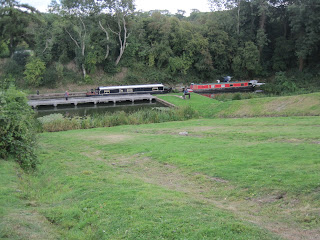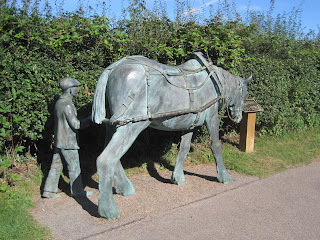A
lovely morning in a lovely spot. We
thought we ought not to languish in bed as Ray and Diane are early risers and
we didn’t want them coming past expecting us to be ready only to find all the
curtains closed!
We
moved up to the swing bridge and waited until the others appeared then opened
the bridge and we all made our way up to Foxton. The men wandered up to see the Lock keeper to
book in while Diane made bacon sandwiches J
 |
| View up the locks |
 |
| View back down the locks |
 |
| The lock keeper explaining how it all works |
 |
| NB Isobel coming into the lock below us |
It
took us 1¼ hours to lock the three boats up the 10 locks and 75 feet. We went first followed by Isobel and then
Ferndale. There were three lock keepers working
so Mike had help and it all worked like clockwork – we just had to remember red
before white and we are all right, white before red and we are dead! I found this on the internet which explains
what I mean. “The water is controlled by
paddles painted red or white. In effect they are big taps, turning the water on
or off. Red paddles fill locks, white empties them. Get the sequence wrong and you risk flooding
the pub!”
When
Benjamin Bevan was given the job of designing locks he faced two major
problems. The first was water, which was in short supply on the 20 mile summit
pound of the canal. The second was the steep escarpment which he needed to use
to get the canal from one level to the next. The flight was built in 1810, and
the top summit route opened four years later. Foxton Locks are the largest
flight of such staircase locks on the English canal system. Side ponds provide
reserves of water for the locks, prevent wastage and speed up traffic.
 |
| The site of the inclined plane |
The
locks at Foxton are narrow and by 1897,
the Grand Junction Canal Company were keen to meet demand from carriers seeking
to use wider beam craft, rather than the traditional narrow beam boats, which
were the only type the locks could accommodate. Their solution was to build an
inclined plane to the side of the locks. Initially, the company had planned for
the plane to replace the locks, rather than having it act as a second, faster
option. Construction began in 1898 and was finished by 10 July 1900. (Rather than me bore you with details of the
inclined plane check it out here
on Wikipedia). In 1926, dismantling of
the incline's machinery began, and it was sold for scrap in 1928 for a mere
£250. That year the chimney on the engine house was demolished and its bricks
used for various canal repairs – how sad.
 |
| The statue of the canal boat horse |
 |
| Foxton |
Clarkes
Bridge to the top of Foxton Locks
1.27
miles10 locks
2 swing bridges

No comments:
Post a Comment